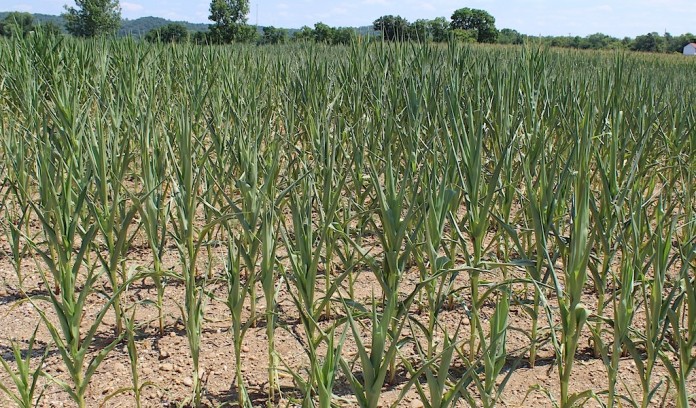Now that grain markets have roared higher on spreading drought across much of the 18 important corn and soybean states, prices have become choppy on any idea we will get rain.
Last week, both July and December corn futures actually lost a little over nine cents as late-week weather forecasts predicted good coverage of scattered rain over much of the Midwest. This followed a week when most areas got a little, but all of the farmers were worried.
If we take a look back, we have seen September corn futures (we will switch our cash bean basis to September futures this week) trade a low of $4.92 1/4 on May 17 and a high of $46.24 3/4 June 21. That is a recent range of $1.32 1/2.
In a similar time, the November soybeans (cash buyers are using September and November futures now for basis) went from a low of $11.30 1/2 May 31 to a high of $13.78 June 21, a range of $2.45 1/2.
Given the recent prices, it would be easy to say they were too cheap a few weeks ago, but it remains to be seen if we are looking at a good price now. If timely rains continue, the party is over. If we get dry in some areas for a week at a time, we have room to move up.
Ohio crops
I had a long talk with a Knox County reader this morning, and I reminded him that even in the Big One in 1988, the party was over when it rained, if I remember the date right, on July 3.
Normally, even in drought markets, we see the corn highs in June, and June is about over when you read this. The crop can get worse, but the market goes up on premature fear.
That Knox County farmer said his corn was not knee-high yet, which is short for him. On the good farms in Northeast Ohio, it has been knee-high for a week, but it is not growing fast.
I am told some soybeans have brown spots in the fields, and as far as I know, this is not from disease, but from poor emergence in powder conditions. The corn roots are still going down, looking for moisture. The beans are trying to live in the first inch or two.
Progress report
The crops we see are being fairly reflected in the U.S. Department of Agriculture crop progress report, out every Monday. We have seen declines in condition for several weeks.
Two weeks ago, Ohio was one of the worst, but we escaped that dubious distinction this week. We actually have a combined rating of the good and excellent categories of 66%. I am surprised it is that high, actually.
The nation as a whole is rated at just 50% good and excellent, down 5% from last week. Last year our rating was 67% at this time. Another reflection of conditions is that one prominent observer has cut his yield estimate another bushel, to 177 bpa. Remember, if we finish with that yield, we have a lot of acres, and we would still add to carryout.
If you are scared to get on to the pricing wagon, remember, that in that 1988 year, we still ended up with something like 85% of the original estimated crop production.
The 81 acres behind my mother’s house tasseled overnight after that July 3 rain and managed to put out 50 or 60 bushels. These are some of the awful memories that I measure markets by, and this one will come out better than that, partly because our planting practices are better and partly because we are not as bad off now as we were with the weather then.
Soybeans
We always say that it is August weather that is most critical for soybeans, as they set pods and fill them, regardless of plant height sometimes. This may be why the USDA soybean crop ratings are still as good as the corn, even though we are seeing some poor stands and very short growth so far.
Ohio came out today with ratings for soybeans of 61 good plus 5 excellent, for a 66% total. The nation as a whole is only at 51%, down three percent from last week. That compares to 65% last year at this time.
Other factors
There are other fundamental factors in the market to talk about. One interesting one is the idea that the Black Sea shipping agreement will not be renewed, as Russia thinks they are getting put at a disadvantage with it. They probably are, as the Ukrainians are determined to export by rail through Poland if they have to.
Meanwhile, wheat prices were up June 27 on the Chicago Board, as a knee-jerk reaction to political problems in Russia over the weekend. The Wagner Group, a large, nasty mercenary army supposedly controlled by Russia and doing their dirty work without the benefit of Russian insignia on otherwise Russian uniforms, revolted as the leadership got into a shouting match with the regular Russian army and started to march on Moscow.
Things have cooled off, but the temporary reaction to war news is always to increase the value of food grains until the truth is traded instead of the rumor.
There are other minor items, such as an upturn in possible soybean sales to China.
The most interesting news to me, and to the future production costs on the farm, is that, even though we saw crude dip below the magic $70 per barrel that the administration said they would use to refill the petroleum reserve, that reserve is now reported at 290 million barrels, the lowest since 1983. It has been emptied to moderate the rise in gasoline and diesel, and it is not being refilled yet.











